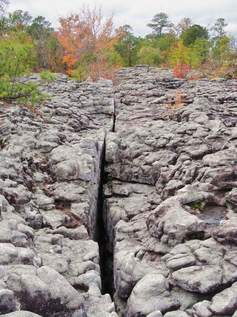 The rain-eroded sandstone surface of Eight Acre Rock near Vance, Alabama. (Photograph by L. J. Davenport)
The rain-eroded sandstone surface of Eight Acre Rock near Vance, Alabama. (Photograph by L. J. Davenport) I ventured south to seek shelter, hoping that the dense surrounding forest would offer protection for plant and human alike. That forest consisted of stunted oaks (chestnut, post, blackjack) and pines (loblolly, shortleaf, longleaf); sweet-gums abounded, and I spotted a single scraggly Georgia hackberry. Sparkleberries seductively dangled their dark blue fruits in my face, and I paused for a tasty snack. Vines grew everywhere, draped lazily from treetops down to the stony floor— muscadine, cross vine, jasmine, and supplejack.
I explored the forest edges where the flat stone pavement, covered with pine needles, glowed with the not-so-subtle shades of football season. White fronds of pineweed offered their tiny yellow-flowered jewels. Curtiss’ milkwort proudly displayed its purple and gold nuggets. Blue-and-orange aster lifted its head ever skyward, while silver-scaled rushfoil caught the day’s last sunrays.
But wait! What’s this? An extensive stand of Menges’ fameflower, with its red-purple petals and succulent tubular leaves, nestled in a bed of reindeer lichen and pinetree moss. What a treasure! Discovered by Brother Wolfgang Wolf (1872–1950) on a monastic perambulation near St. Bernard’s Abbey in Cullman, this gorgeous plant only grows on similar sandstone outcrops in the Southeast.
But what’s this pea gravel doing here? I followed it to its source, a crumbling path of man-made conglomerate bordered by hairy-lip ferns. And suddenly I realized that I had stumbled into someone’s secret garden, abandoned and sealed off from the world. Who built this place? And when? And why? The path led to a buckled bridge spanning a chasm lined with sourwood trees, their bright red leaves and tawny brown fruits hanging limp in the moist air. Cement stairs took me down through a grove of golden bamboos, nurtured long ago and now reaching forty feet high. The grove bordered a north-facing wall festooned with streaming mosses, looking much like frozen cascades of bright green water. Around the corner, a south-facing wall lay mostly bare. As I followed the meandering sink, the mosses appeared and disappeared as if on cue--north wall YES, south wall NO.
And YES, I was in a rural Alabama version of Frances Hodgson Burnett’s classic children’s book: “Bama Rock Garden” by name, built fifty years ago to rival Rock City. Like Burnett’s heroine, Mary Quite Contrary, I marveled at all that I saw--the hanging hands of marginal shield fern, dark green and majestic; the mounds of resurrection fern, born-again by the icy rain; the towering wands of Adam’s needle in the lush gullies; and the prickly pads of prickly pear on the bare expanses above.
Circling back to the deer trail, I solemnly bowed to this sacred place before scratching my way back to the truck. And I wondered, as Larry Not-So-Contrary should: What will springtime bring to my secret rock garden? Will the pure white faces of false garlics rise up from hidden bulbs? Will diamorpha paint everything else a brilliant crimson? I can’t wait to see it!
Author
Larry Davenport is a professor of biology at Samford University in Birmingham, Alabama.
This feature was previously published in Issue #100, Spring 2011.
 RSS Feed
RSS Feed